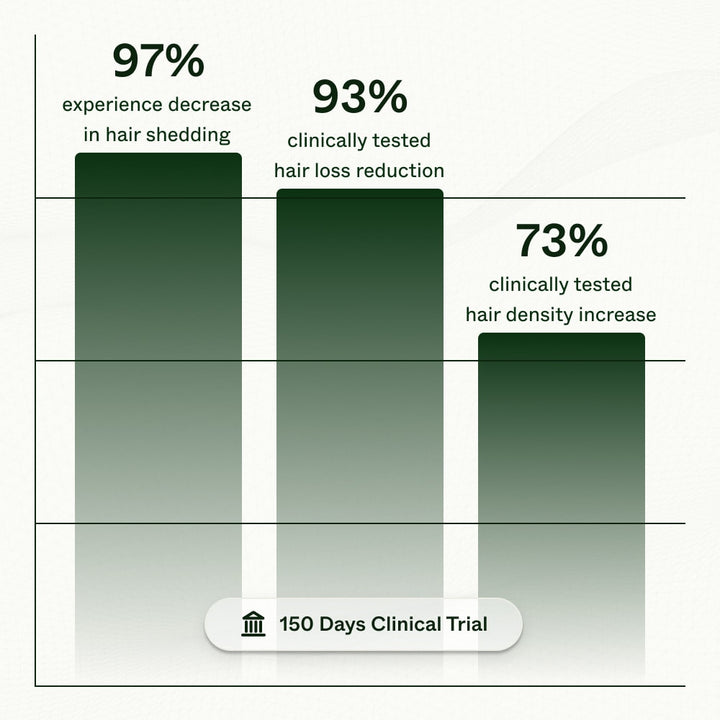If you do not want to diagnose these yourself, check out our most powerful hair loss AI yet - TrichoAI.
It can help you detect your hair loss condition in under 30 seconds, combining clinical knowledge from board-certified dermatologists and the newest AI technology to date.
Noticing hair thinning or increased hair shedding can be a distressing experience, leaving many wondering, "Are you balding?"
Premature hair loss is more than just a cosmetic concern; it can significantly impact emotional well-being and self-confidence. However, recognizing the first signs of hair loss and taking proactive measures can greatly enhance your chances of halting further hair loss and even help grow hair back.
Table of content
How to Recognize the Early Signs of Balding?

These are five tell-tale signs of balding that even professionals use for diagnosing hair loss, and how to easily do them at home.
1. Thinning Hair on the Crown and Receding Hairline
It's different based on what your assigned sex at birth.
Men (or MAAB):
Regularly take photographs of your hairline from multiple angles under similar lighting conditions. Pay special attention to the temples and the forehead region.
Over time, compare these images to identify any recession or thinning patterns, particularly the development of an "M" shape.
This pattern is a classic sign of male pattern baldness (androgenic alopecia).
Women (or FAAB):
Use a comb to part your hair down the middle and take close-up photos of the part.
Observe for any widening of the part or increased scalp visibility on the top of your head, which can indicate the first signs of hair fall.
Women tend to experience diffuse thinning over the entire scalp area rather than a receding hairline.
2. Excessive Hair Loss
Obsessive? Probably. Effective? Very!
Each morning, inspect your pillow for any hair falls. An increase in the amount of hair compared to what you've normally observed could be a sign of enhanced shedding. Keep in mind that it's normal to shed between 50-100 strands per day.
Monitor the amount of hair collecting in the shower drain and on your hairbrush after use. A significant increase in hair accumulation can indicate a change in your hair's shedding pattern. Keep a weekly tally or take photos for comparison. Excessive shedding can be a sign of telogen effluvium, a temporary hair loss condition triggered by stress, illness, or hormonal changes.
3. Patchy Bald Spots and Scalp Visibility
Regularly examine your scalp in a well-lit room with a handheld mirror or ask someone to help. Look for any smooth, coin-sized bald spots or areas where the scalp is more visible than before. This can be a sign of alopecia areata, an autoimmune condition that causes patchy hair loss.
In areas previously covered by hair, notice if the scalp becomes more visible or if the hair part widens, indicating thinning. This can be a sign of androgenic alopecia (male pattern baldness or female hair loss) or other types of hair loss.
4. Itchy Scalp
Keep a diary of scalp sensations. Note any occurrences of itchiness, tenderness, or pain, and their locations on the scalp. This could be indicative of inflammatory conditions such as seborrheic dermatitis or psoriasis, which can precede or accompany hair loss.
5. Sudden Hair Loss
Reflect on any recent life events that have been particularly stressful, such as a major illness, surgery, or trauma. Following these events, observe if hair seems to come out more easily when washing or gently pulling on it. This could be a sign of telogen effluvium, a condition often triggered by stress, where the follicles prematurely enter the resting phase.
6. Textural Changes
Pay attention to the texture of your hair strands. Collect a few hairs from different parts of your head and compare their thickness and texture. More hair may become finer and weaker over time, which can be an early indicator of hair loss. This can be caused by factors like nutritional deficiencies or hormonal imbalances.
As your leading source for hair health information over the past 4 years, we never compromise on accuracy. When it comes to your health, you deserve information you can truly rely on - and earning your trust is our top priority.
Here's how Scandinavian Biolabs ensures every piece of content meets the highest standards of accuracy and integrity:
- Credentialed Experts: Our reviewers are actively practicing doctors and medical researchers
- Stringent Reviews: Content undergoes rigorous editing by subject specialists and review by a practicing doctor.
- Evidence-Based: We rely on well-established research from trusted scientific sources like peer-reviewed journals and health authorities.
- Full Transparency: Our editorial standards, writer credentials, reviewer credentials, correction process, and funding are all publicly documented.
- Independent Voice: While we do promote products, we operate in a vacuum to business operations. Our main goal is just an unwavering commitment to providing medically-sound guidance.
You can count on Scandinavian Biolabs to consistently deliver the trustworthy health information you deserve. Read our Editorial Standards.
Scientific Methods for Early Detection

While at-home observations can provide valuable insights, healthcare professionals may recommend more advanced diagnostic techniques for a comprehensive evaluation.
Here are what they might do:
Scalp Biopsy
A detailed examination of follicles through a scalp biopsy can reveal underlying issues contributing to hair loss, such as scarring alopecia or other conditions affecting the follicles' health.
Trichoscopy
This non-invasive method employs a specialized microscope (trichoscope) to assess the scalp and hair follicles' health and thickness. It can identify patterns and abnormalities that may indicate specific types of hair loss.
Blood Tests
Identifying internal factors that affect hair health, such as hormonal imbalances (e.g., thyroid disorders, excessive androgens), nutritional deficiencies (e.g., iron, vitamin D), or autoimmune conditions, can be achieved through blood tests.
At-Home Detection Methods

While not as comprehensive as professional evaluations, these at-home methods can provide valuable insights into your hair's health and potential shedding patterns.
The Hair Pull Test
Gently pulling a small hair section (about 60-100 strands) to see how many strands come out can indicate increased shedding if more than 10-15 strands are removed. This test should be performed in multiple areas of the scalp for a more accurate assessment.
The Comb Check
Combing your hair after washing and noting the strands left in the comb can help detect excessive hair loss. It's normal to lose hair a few hairs during brushing or combing, but an excessive amount can be a cause for concern.
DIY Scalp Inspection
Using a hand mirror to regularly check your scalp for signs of hair loss, increased scalp visibility, or bald patches can be an effective self-monitoring tool. Take photos under consistent lighting conditions for easier comparison over time.
How to Stop Your Hair Thinning?
Once you've identified potential signs of balding, it's essential to take action to stimulate hair growth and help treat hair loss.
There are several methods you can try to help you stop losing hair and get back your full head of hair:
Scandinavian Biolabs Hair Growth Routine

Our unique formula, enriched with clinically-tested ingredients, is tailored to nourish your hair follicles deeply and reignite the growth of stronger, more vibrant hair.
Experience the power of cutting-edge stem cell technology, harnessing the potency of multiple plant growth factors in each product. This advanced approach is engineered to fortify your hair follicles, help to reduce hair loss, and paving the way for fuller, healthier hair growth.
Our formulations are backed by these impressive clinical study results

Don't let hair loss hold you back any longer. Embrace the solution that supports hair growth and maintains the vitality of your hair.
Start your journey to reclaiming your confidence with hair that feels and looks stronger than ever before.
Minoxidil & Finasteride
These FDA-approved hair loss treatments have been shown to effectively combat male pattern baldness and female pattern baldness by targeting the underlying causes of hair loss. Minoxidil is typically a topical solution that promotes growth, while finasteride is usually an oral medication that blocks the hormone dihydrotestosterone (DHT), which contributes to hair loss.
Derma Rolling
This technique involves using a micro-needling device (dermaroller) to create tiny punctures in the scalp, stimulating the scalp and improving hair follicle absorption of hair growth products like topical minoxidil and hair serums. It can also promote collagen production and improve blood flow to the scalp which can help produce hair.
As mentioned above, this method is most effective when combined with a topical solution that targets your type of hair loss.
Hair Supplements
Nutrient deficiencies can be why hair loss occurs. Supplements containing biotin, iron, zinc, vitamin D, and other essential vitamins and minerals can support healthy growth by addressing nutritional imbalances.
Our busy lives often leave very little time to ensure we get all the nutritional requirements our hair needs through diet, therefore, it is recommended to take hair supplements to help regrow hair.
Essential Oils
Oils like peppermint, rosemary, and cedarwood have been traditionally used to promote scalp health and stimulate follicles. They can be added to carrier oils and massaged into the scalp or used in hair masks for added benefits.
Numerous studies have been done, especially on popular essential oils like rosemary, stinging nettle, and pumpkin seed oil to show its potency to help regrow hair for those who experience hair thinning.
Hair Growth Promoting Procedures

Techniques like low-level laser therapy (LLLT), platelet-rich plasma (PRP) therapy, and hair transplant can be effective hair loss treatment options for more advanced and permanent hair loss.
- LLLT uses low-intensity light to stimulate follicles,
- PRP involves injecting platelet-rich plasma from the patient's own blood into the scalp to regrow new hair.
- Hair transplant involves surgically moving healthy hair follicles from one area of the scalp to the balding or thinning areas. Hair transplants are usually expensive and require a bit of downtime.
These procedures often cost quite a bit and some might require a lot of time taken for consultation. It's usually recommended if other methods did not work to help with your hair thinning.
FAQs
Do I have male pattern baldness?
Look for a receding hairline, thinning on the crown and temples, and a developing bald spot on the top of the head. Male pattern baldness, or androgenetic alopecia, typically follows a pattern of hair loss that starts with a receding hairline and progresses to thinning on the crown and temples.
Do I have female pattern baldness?
If you notice gradual thinning at the part line, widening of the part, and increased hair shedding, you might have female pattern baldness. This condition, often genetic, leads to diffuse thinning without a receding hairline.
What can you do to stimulate hair follicles?
Stimulating hair follicles can involve various treatments and techniques, including minoxidil, laser therapy, microneedling, scalp massages, and natural remedies aimed at improving scalp health and promoting hair regrowth. The best approach depends on the underlying cause of your hair loss and should be determined in consultation with a professional.
What is hair loss?
Hair loss, particularly male pattern baldness (or androgenetic alopecia), is a common type of hair loss affecting many individuals.
This condition is characterized by a recognizable hair loss pattern, including a receding hairline and thinning on the crown, often leading to significant hair loss.
When you notice thinning hair, which can early signs that you're experiencing early balding.
Why do you have hair loss?
The hair growth cycle is disrupted in male pattern hair loss, resulting in shorter growth phases and thinner hair. Depending on your type of hair loss, there are many potential causes, even underlying medical condition in some hair loss conditions.
Factors contributing to this condition include genetics and hormonal changes, which do not necessarily affect body hair in the same way.
Other types of hair loss, such as alopecia areata, involve the immune system attacking hair follicles, potentially leading to severe hair loss and permanent scarring.
Additionally, underlying medical conditions, like high blood pressure and weight gain, can also play a role in hair loss. Addressing these health issues with medical treatments may help manage patterned hair loss.
How do I know if I am balding?
You can identify balding by noticing signs such as a receding hairline, thinning of hair on the top of your head, more hair falling out than usual (especially if you find hair on your pillow, in the shower, or on your brush), and seeing more of your scalp than before.
Another indicator is if your partings become wider or you can see your scalp more easily through your hair. If family members have experienced male or female pattern baldness, you might be more prone to balding as well, given its hereditary nature.
Is my hair thin or just balding?
Thinning hair refers to a reduction in hair density, where you may notice that your hair doesn't feel as thick as it used to, but it doesn't necessarily mean you're balding. Balding, particularly male or female pattern baldness, involves a more distinct pattern of hair loss, such as a receding hairline, thinning at the crown, or widening part lines.
If the thinning is uniform across your scalp, it might just be thin hair. However, if you notice specific areas of reduced density progressing over time, it could be a sign of balding.
Am I bald or just paranoid?
Feeling paranoid about balding is common, especially if you're aware of the signs or have a family history of hair loss. To determine if your concerns are valid, look for tangible signs of hair loss, such as a receding hairline, noticeable thinning spots, more hair falling out than usual, or visible scalp where hair used to be denser.
If you're unsure, consulting with a dermatologist or a trichologist can provide clarity. Or, use our TrichoAI here.
They can help assess your hair and scalp health to confirm if you're experiencing balding or if your worries might be unfounded.
At what age do men start balding?
Men can start balding as early as their late teens or early 20s, with the most common type of hair loss being male pattern baldness (androgenetic alopecia).
By the age of 35, approximately two-thirds of American men will experience some degree of appreciable hair loss, and by the age of 50, about 85% of men have significantly thinner hair.
However, the onset and progression of balding vary widely among individuals, influenced by genetics, hormonal factors, and health conditions.
Conclusion
The key to managing premature balding effectively lies in early detection and prompt action. Being proactive about the first signs of hair loss and consulting with healthcare professionals can lead to significant improvements in preserving and regrowing hair.
While genetics plays a role in hair loss, lifestyle factors such as diet, stress management, and proper hair care also significantly impact your hair's health.
Equip yourself with the right knowledge, take decisive steps towards treatment, and consult with specialists to embark on your journey towards healthier hair.
Read more:
- Best 15 Shampoos for Hair Loss in Men: These Works For Your Hair
- Does Creatine Cause Hair Loss? We Revisited The Evidence
- The Connection Between Itchy Scalp and Hair Growth: What You Need to Know
Reference
https://pubmed.ncbi.nlm.nih.gov/32700775/









